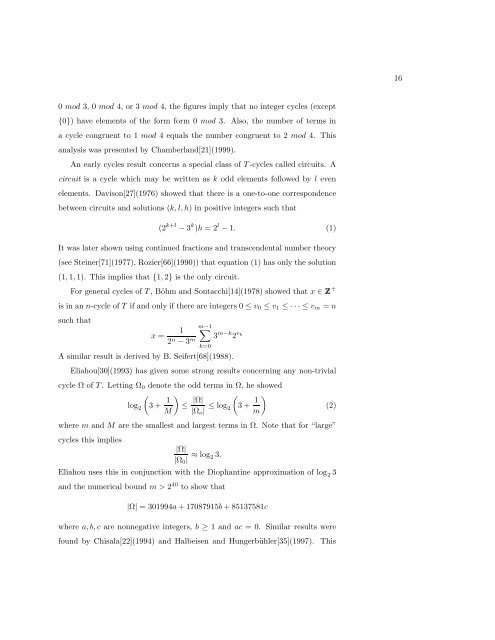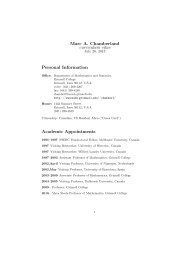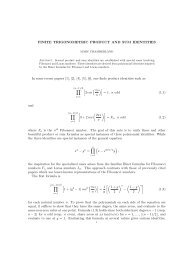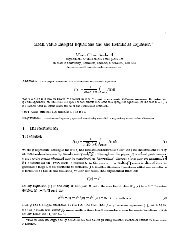An Update on the 3x+1 Problem Marc Chamberland Contents
An Update on the 3x+1 Problem Marc Chamberland Contents
An Update on the 3x+1 Problem Marc Chamberland Contents
Create successful ePaper yourself
Turn your PDF publications into a flip-book with our unique Google optimized e-Paper software.
16<br />
0 mod 3, 0 mod 4, or 3 mod 4, <strong>the</strong> figures imply that no integer cycles (except<br />
{0}) have elements of <strong>the</strong> form form 0 mod 3. Also, <strong>the</strong> number of terms in<br />
a cycle c<strong>on</strong>gruent to 1 mod 4 equals <strong>the</strong> number c<strong>on</strong>gruent to 2 mod 4. This<br />
analysis was presented by <strong>Chamberland</strong>[21](1999).<br />
<str<strong>on</strong>g>An</str<strong>on</strong>g> early cycles result c<strong>on</strong>cerns a special class of T -cycles called circuits. A<br />
circuit is a cycle which may be written as k odd elements followed by l even<br />
elements. Davis<strong>on</strong>[27](1976) showed that <strong>the</strong>re is a <strong>on</strong>e-to-<strong>on</strong>e corresp<strong>on</strong>dence<br />
between circuits and soluti<strong>on</strong>s (k, l, h) in positive integers such that<br />
(2 k+l − 3 k )h = 2 l − 1. (1)<br />
It was later shown using c<strong>on</strong>tinued fracti<strong>on</strong>s and transcendental number <strong>the</strong>ory<br />
(see Steiner[71](1977), Rozier[66](1990)) that equati<strong>on</strong> (1) has <strong>on</strong>ly <strong>the</strong> soluti<strong>on</strong><br />
(1, 1, 1). This implies that {1, 2} is <strong>the</strong> <strong>on</strong>ly circuit.<br />
For general cycles of T , Böhm and S<strong>on</strong>tacchi[14](1978) showed that x ∈ Z +<br />
is in an n-cycle of T if and <strong>on</strong>ly if <strong>the</strong>re are integers 0 ≤ v 0 ≤ v 1 ≤ · · · ≤ v m = n<br />
such that<br />
m−1<br />
1 ∑<br />
x =<br />
2 n − 3 m 3 m−k 2 v k<br />
k=0<br />
A similar result is derived by B. Seifert[68](1988).<br />
Eliahou[30](1993) has given some str<strong>on</strong>g results c<strong>on</strong>cerning any n<strong>on</strong>-trivial<br />
cycle Ω of T . Letting Ω 0 denote <strong>the</strong> odd terms in Ω, he showed<br />
(<br />
log 2 3 + 1 )<br />
≤ |Ω| (<br />
M |Ω o | ≤ log 2 3 + 1 )<br />
m<br />
where m and M are <strong>the</strong> smallest and largest terms in Ω. Note that for “large”<br />
cycles this implies<br />
|Ω|<br />
|Ω 0 | ≈ log 2 3.<br />
Eliahou uses this in c<strong>on</strong>juncti<strong>on</strong> with <strong>the</strong> Diophantine approximati<strong>on</strong> of log 2 3<br />
and <strong>the</strong> numerical bound m > 2 40 to show that<br />
|Ω| = 301994a + 17087915b + 85137581c<br />
where a, b, c are n<strong>on</strong>negative integers, b ≥ 1 and ac = 0. Similar results were<br />
found by Chisala[22](1994) and Halbeisen and Hungerbühler[35](1997). This<br />
(2)





